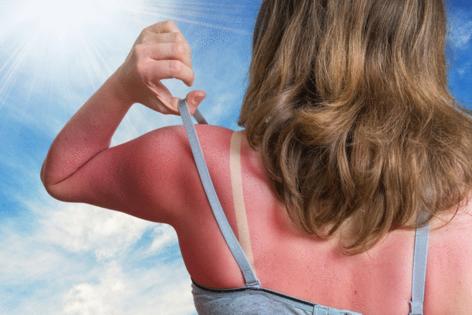When is a sunburn cause for concern?
Published in News & Features
Jul. 27—Sunburns are common — about a third of Americans get at least one each year — and are, most of the time, mild or treatable. But some burns are more severe than others.
More than 33,000 sunburns requiring emergency room consultation are reported each year, according to the National Cancer Institute.
Here's what to know and when to seek additional treatment.
What is a sunburn?
Sunburns occur when radiation from the sun damages the skin, leading to DNA damage. The redness and pain characteristic of a sunburn are the body's inflammatory response to that damage. This can cause skin cancer later.
The sun emits ultraviolet radiation at three different wavelengths, labeled as UV A, B and C. UVC is blocked by Earth's ozone layer, but the other two wavelengths penetrate past it.
UVA is thought of by dermatologists as UV "aging," because these rays break down collagen and contribute to sunspots and wrinkles, accelerating our skin's aging process.
"We say B stands for burning, and UVB is actually the main culprit that results in our sunburns," said Joe Tung, medical director of UPMC's outpatient dermatology clinic and a team dermatologist for the Pittsburgh Penguins.
What are the risks of sunburn?
Sunburns may lead to pain, discomfort and skin peeling — and, or if more severe, skin blistering — in the days and weeks after the burn occurs.
UV radiation is cumulative, so while a sunburn is an acute event, getting five sunburns doubles one's risk of melanoma, a form of skin cancer.
"Even when your skin heals, it's never quite the same after that," said Tung. "You do have some residual damage that's almost like a permanent marker on your DNA. And it's that cumulative exposure over time that leads to things like skin cancer."
And while the five-year survival rate of melanoma is 99% when caught early, if melanoma spreads, that rate drops to 35%, per the American Cancer Society.
"Any sunburns you get can really contribute to your chances of getting skin cancer," said Christie Regula, cofounder of the Scott Township skin-cancer advocacy group Sun Smart Pittsburgh and a dermatologist.
Her clinic has been seeing an increase in melanoma in recent years, especially in young women, she said, potentially attributable to sunburns and tanning beds.
What are the types of sunburn?
A first-degree sunburn burns the top layer of skin, or the epidermis. The body's response to a mild sunburn will peak at 12 to 24 hours after exposure, when a person may notice the area is red, tender to the touch, painful or itchy. When a sunburn peels a week or so later, that's the dead and damaged epidermis peeling off.
A second-degree sunburn means UV rays have penetrated beyond the epidermis to the dermis, leading to blistering, swelling and the risk of infection. Depending on the severity, a second-degree burn may require medical treatment.
A third-degree sunburn, which is very rare, means UV rays have damaged the fat layer and nerve cells under the skin, leading to numbness, tingling and white, leathery or burned patches. A person with this burn will also be experiencing heat exhaustion or heat stroke and may be confused, dizzy, dehydrated, shivering or unable to sweat. This is a medical emergency.
Common sunburn misconceptions
Dermatologists say they often hear people erroneously say it's not possible to get a sunburn on a cloudy day or that a base tan early in the summer season can protect you from a sunburn later.
UV rays can penetrate clouds, and the UV index, a measure of the sun's strength, can be high on a hazy day, leading to sunburn. And those interviewed said even a base tan is evidence of skin damage, and will not protect you from future burns.
Most people don't use enough sunscreen or don't coat the body evenly, said Regula. If you're spending a week on the beach and you don't use the whole bottle, you're not using enough, she said.
And even if you get a sunburn here or there, the risk for skin cancer is still present.
"I see a lot of patients with skin cancer, and it's common that they say, 'I don't go out in the sun anymore,'" said Regula. "It's important for people to know it's cumulative. It really is later in life that it can show up."
How should sunburns be treated?
Most sunburns can be treated at home with over-the-counter pain medications and moisturizer.
"Once you have a sunburn, it's really about supportive care," said Regula. "We can't reverse the damage, but there are things that can be helpful to make the skin feel better."
For a mild sunburn, moisturize the area with a gentle, fragrance-free lotion like CeraVe or Cetaphil, or use aloe vera gel for its cooling and soothing properties. A cool, damp cloth may also soothe the skin.
The inflammatory response of a sunburn — especially if it's second-degree — means there could be fluid loss, and the body is working harder to heal the damaged area. Stay hydrated with water and electrolytes and keep blistered areas moist with petroleum gel, gentle lotion or a damp cloth.
If blisters are large or you see signs of infection, such as pus or streaking redness, or if the burn starts to cover a larger area of your body, seek additional treatment, said Tung.
Systemic symptoms, like nausea, fever or chills are also a cue to get help.
"Signs of second-degree burns, infection on top of the sunburn, heat exhaustion, those are all things that we would be concerned about," he said.
Someone with a third-degree burn should go to the emergency room. They will look and feel ill, said Charles Mount, associate director of Allegheny Health Network's Skin Cancer Center at West Penn and a dermatologist.
"They are going to have fever, chills and look like they have the flu," he said. "This is usually not a subtle thing."
Preventing future burns
It's easier to prevent a sunburn than to treat one. That's why sun protection is key.
Experts recommended broad spectrum sunscreen (this means it protects against multiple types of UV rays) with at least SPF 30, and to reapply every two hours.
Sun-protective clothing is ideal because it doesn't carry the risk of uneven application or necessitate reapplication. Outdoor brands such as REI and Columbia sell sun-protective clothing, and more cost-effective options are available at retailers including Walmart, Costco and Uniqlo.
And don't forget a hat and sunglasses to protect your face and eyes.
Increasing awareness
Awareness about the benefits of sunscreen and the risks of sunburns does seem to be increasing, say dermatologists.
For melanoma, this awareness lead to a drop in mortality, as cases were caught earlier.
"I grew up in the '80s and '90s, and we were lucky to put (sunscreen) on once in the day, maybe a second time after lunch," said Mount. "For my parents, there wasn't sunscreen. Every generation does it a little bit better."
The Pennsylvania Department of Conservation and Natural Resources will still be offering free sunscreen at the more than 50 state parks it announced last year, but will not be adding new participating locations, said Christina Novak, the agency's communications director.
Sun Smart Pittsburgh, a nonprofit that Regula began with a colleague about in 2016, has installed 27 free sunscreen dispensers to date in public spaces including parks and playgrounds.
_____
© 2025 the Pittsburgh Post-Gazette. Visit www.post-gazette.com. Distributed by Tribune Content Agency, LLC.







Comments